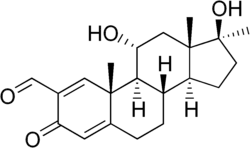 | |
 | |
| Clinical data | |
|---|---|
| Trade names | Esiclene, Hubernol, Metanor |
| Other names | Formyldienolone; 2-Formyl-11α-hydroxy-17α-methyl-δ1-testosterone |
| Routes of administration | Oral |
| Legal status | |
| Legal status | |
| Identifiers | |
| |
| CAS Number | |
| PubChem CID | |
| ChemSpider | |
| UNII | |
| ChEMBL | |
| CompTox Dashboard (EPA) | |
| ECHA InfoCard | 100.017.749 |
| Chemical and physical data | |
| Formula | C21H28O4 |
| Molar mass | 344.451 g·mol−1 |
| 3D model (JSmol) | |
| |
| |
| | |
Formebolone (INN, BAN) (brand names Esiclene, Hubernol, Metanor), also known as formyldienolone, as well as 2-formyl-11α-hydroxy-17α-methyl-δ1-testosterone, is an orally active anabolic-androgenic steroid (AAS) described as an anticatabolic and anabolic drug that is or has been marketed in Spain and Italy.[2][3][4] As an AAS, it shows some anabolic activity, though it is inferior to testosterone in terms of potency, but is said to have virtually no androgenic activity.[5] Formebolone counteracts the catabolic effects (control of nitrogen balance) of potent glucocorticoids like dexamethasone phosphate.[5][6] A close analogue, roxibolone (and its long-acting ester variant decylroxibolone), shows similar antiglucocorticoid activity to formebolone but, in contrast, is devoid of activity as an AAS.[7]
Roxibolone has been found not to bind to the glucocorticoid receptor, and it has been suggested that the antiglucocorticoid activity of roxibolone and formebolone may instead be mediated by modulation of enzymatic processes.[8] Indeed, 11α- and 11β-hydroxyprogesterone (formebolone and roxibolone being 11α- and 11β-hydroxylated (respectively) similarly) are known to be potent inhibitors of 11β-hydroxysteroid dehydrogenase (11β-HSD), which is responsible for the biosynthesis of the potent endogenous glucocorticoids cortisol and corticosterone (from the precursors deoxycortisol and deoxycorticosterone, respectively).[9][10] However, formebolone was found to be a very weak inhibitor of 11β-HSD type 2 (IC50 > 10 μM), although this specific isoenzyme of 11β-HSD is responsible for the inactivation of glucocorticoids rather than their production.[11]
References
- ↑ Anvisa (2023-03-31). "RDC Nº 784 - Listas de Substâncias Entorpecentes, Psicotrópicas, Precursoras e Outras sob Controle Especial" [Collegiate Board Resolution No. 784 - Lists of Narcotic, Psychotropic, Precursor, and Other Substances under Special Control] (in Brazilian Portuguese). Diário Oficial da União (published 2023-04-04). Archived from the original on 2023-08-03. Retrieved 2023-08-15.
- ↑ Index Nominum 2000: International Drug Directory. Taylor & Francis. January 2000. pp. 471–. ISBN 978-3-88763-075-1.
- ↑ Elks J (14 November 2014). The Dictionary of Drugs: Chemical Data: Chemical Data, Structures and Bibliographies. Springer. pp. 577–. ISBN 978-1-4757-2085-3.
- ↑ Morton IK, Hall JM (31 October 1999). Concise Dictionary of Pharmacological Agents: Properties and Synonyms. Springer Science & Business Media. pp. 125–. ISBN 978-0-7514-0499-9.
- 1 2 Gelli D, Vignati E (1976). "Metabolic studies with formebolone (2-formyl-17 (alpha)-methyl-androsta-1,4-diene-11 (alpha), 17 (beta)-diol-3-one) in humans". The Journal of International Medical Research. 4 (2): 96–105. doi:10.1177/030006057600400203. PMID 799985. S2CID 86157607.
- ↑ Cerutti S, Forlani A, Galimberti E (1976). "Anticatabolic action of formebolone in the castrated rat treated with dexamethasone". Arzneimittel-Forschung. 26 (9): 1673–1677. PMID 1036699.
- ↑ Felippone F, Resnati G, Scolastico C, Tronconi G (March 1984). "Synthesis of 2-carboxy-11 beta, 17 beta-dihydroxy-17-methyl-1, 4-androstadien-3-one and related compounds". Steroids. 43 (3): 271–282. doi:10.1016/0039-128x(84)90045-x. PMID 6523544. S2CID 54289377.
- ↑ Dahlberg E, Snochowski M, Gustafsson JA (April 1981). "Regulation of the androgen and glucocorticoid receptors in rat and mouse skeletal muscle cytosol". Endocrinology. 108 (4): 1431–1440. doi:10.1210/endo-108-4-1431. PMID 6970661.
- ↑ Souness GW, Latif SA, Laurenzo JL, Morris DJ (April 1995). "11 alpha- and 11 beta-hydroxyprogesterone, potent inhibitors of 11 beta-hydroxysteroid dehydrogenase (isoforms 1 and 2), confer marked mineralocorticoid activity on corticosterone in the ADX rat". Endocrinology. 136 (4): 1809–1812. doi:10.1210/endo.136.4.7895695. PMID 7895695.
- ↑ Souness GW, Morris DJ (March 1996). "11 alpha- and 11 beta-hydroxyprogesterone, potent inhibitors of 11 beta-hydroxysteroid dehydrogenase, possess hypertensinogenic activity in the rat". Hypertension. 27 (3 Pt 1): 421–425. doi:10.1161/01.hyp.27.3.421. PMID 8698448.
- ↑ Fürstenberger C, Vuorinen A, Da Cunha T, Kratschmar DV, Saugy M, Schuster D, Odermatt A (April 2012). "The anabolic androgenic steroid fluoxymesterone inhibits 11β-hydroxysteroid dehydrogenase 2-dependent glucocorticoid inactivation". Toxicological Sciences. 126 (2): 353–361. doi:10.1093/toxsci/kfs022. PMID 22273746.